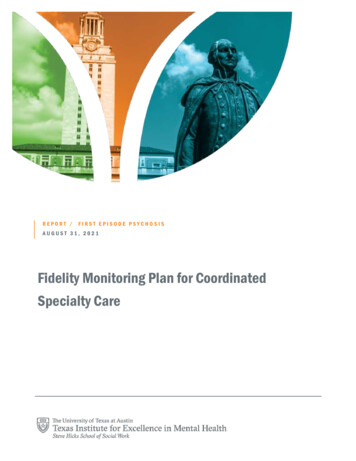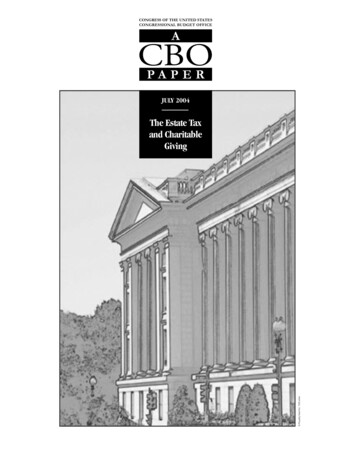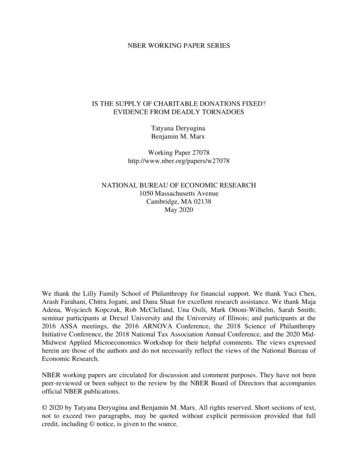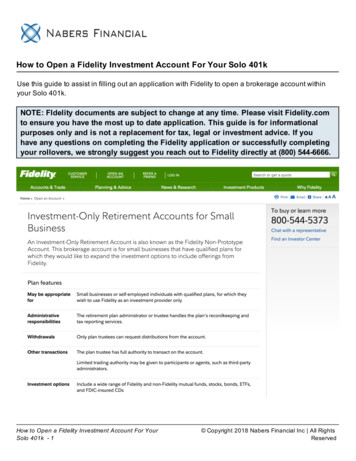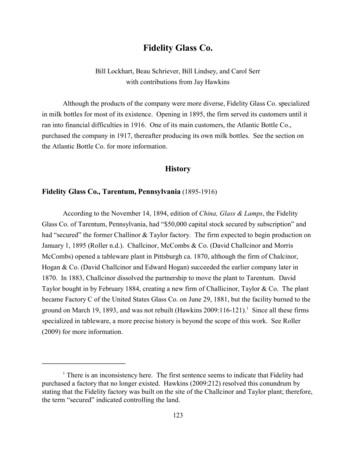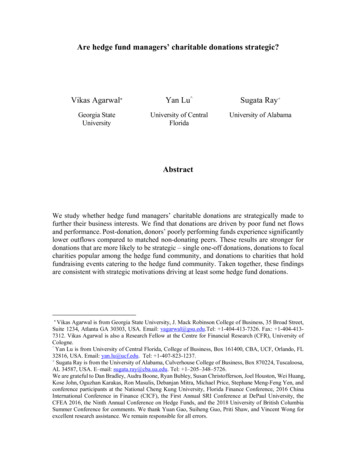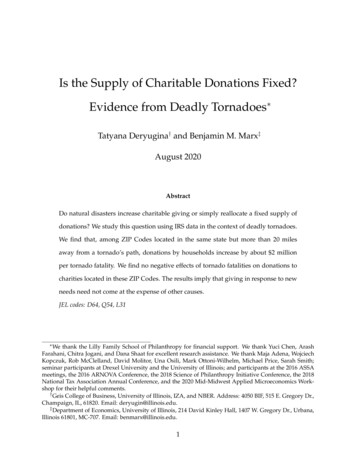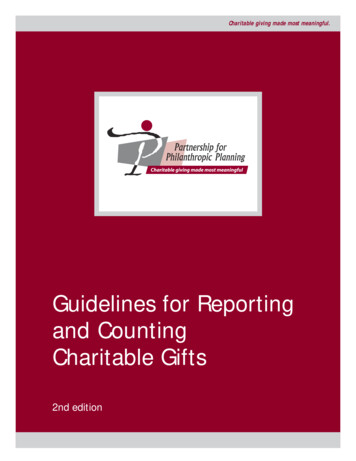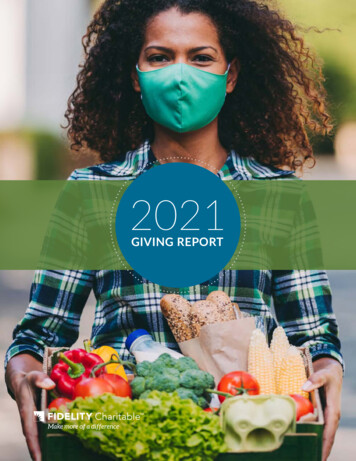
Transcription
2021GIVING REPORT
Pamela J. NorleyPresidentFidelity CharitableWhen the shocking effects of the COVID-19 pandemic began taking form,Amanda Millerberg, a Fidelity Charitable donor from Salt Lake City, knew sheand her family had a role to play. After recommending grants to cover the cost of280 bags of food for local nonprofit USANA Kids Eat, she, her husband, Spencer,and their five children showed up in-person to pack the bags for local families.And then they turned to social media to encourage their friends and neighborsto pitch in—securing enough donations to fund the organization’s COVID-19 foodprogram 100 percent.2020 was a difficult year for us all, but when I look back, what I will remembermost is the spirit of donors like the Millerbergs—a regular family who refused to turn away from the sufferingthey saw and instead chose to take action. Our growing donor community is full of these generous individuals,and together, they recommended a record-breaking 2 million grants totaling 9.1 billion in 2020. These grantssupported more than 170,000 unique nonprofits, many of them small or midsized, and the populations they serve.Navigating the unknown of a global pandemic, Fidelity Charitable donors chose to respond with compassionand concern for others over themselves. Our community addressed medical needs related to COVID-19 withgrants providing much-needed protective equipment to gifts that funded research and helped speed theproduction of a vaccine. The economic impacts of the crisis were equally dangerous and devastating to manyfamilies, and donors worked to provide financial assistance to the newly unemployed and meals to those whostruggled with food insecurity. Granting to free food programs multiplied more than twelvefold from 2019,much of which went to small and local food banks around the country.Along with our donors, we at Fidelity Charitable were in uncharted waters. In the early days of the pandemic,we heard from donors who wished to help, but weren’t sure how they could. We worked quickly with partnersacross the sector to produce giving guidance, including web content and webinars that generated nearly 400,000views. In addition, we doubled the number of organizations enrolled in our electronic funds transfer (EFT)program so that more charities could receive much-needed grant funds more quickly. In a time of crisis andconfusion, I am proud that our organization rose to the occasion and helped make giving more effectiveand efficient when nonprofits needed it most.
While our grantmaking results were remarkable in and of themselves, they could also indicate future trendsmolding the giving landscape. For example, nonprofits’ response to the pandemic was fluid as many were forcedto alter the way they provide services—which increased the importance of unrestricted gifts that they can usefor their most urgent needs. Nearly two-thirds of donor grant recommendations went “where needed most”—a slight increase from 2019 and an encouraging shift for the changing needs of the sector.Social distancing orders also forced the philanthropic community to become fluent with virtual-first fundraisingand making digital connections with donors—a trend that will continue as tech-savvy Millennials play a biggerrole in philanthropy.The ongoing movement for social justice has also encouraged many donors to consider their giving througha racial equity lens and to support minority-led organizations. In addition to the outpouring of support forCOVID-19 relief, for example, Giving Account support multiplied to many organizations fighting for justiceand equality—such as the Equal Justice Initiative, which made its debut on our list of most popular nonprofitsof the year.More than anything, a tumultuous 2020 reinforced the power of donor-advised funds to serve as a ready-reservefor philanthropy during times of crisis. With funds already committed to charity, donors were able to respondquickly to pandemic-related needs—but they also maintained giving for the causes and organizations theynormally support. This consistent funding was vital to the philanthropic sector in 2020, as many nonprofitsfaced declining revenue streams even as demand for their services increased.It was a year unlike any other, and I am honored to be part of this extraordinary movement of generosity.As we look ahead to recover and rebuild, we remain steadfast in our commitment to provide donors with thetools and guidance they need to be effective philanthropists. And as we kick off our celebration of FidelityCharitable’s 30th anniversary, we are more committed than ever to making smarter charitable giving accessible,simple, and effective.Table of Contents4 Executive Summary23 Funding Donor Giving7 Who are Fidelity Charitable’s Donors?28 Fidelity Charitable: 30 Years of Giving10 Donors’ Charitable Support19 Trending Topics in Granting
2021 Giving ReportExecutive SummaryExtraordinary circumstances inspired extraordinary generosity in 2020, leadingFidelity Charitable donors to recommend 2 million grants totaling 9.1 billion.Our community of more than 250,000 donors was a sustaining force inphilanthropy—supporting more than 170,000 unique charities and maintainingFidelity Charitable’s position as the nation’s largest grantmaker.In a year like 2020, strategic philanthropy was moreIn the tragedy and confusion of 2020, Fidelity Charitableimportant than ever. More people are turning to donor-donors acted on their careful philanthropic plans—withadvised funds to maximize their charitable giving andmany turning to a Giving Account to put their compassionmake more effective and tax-efficient donations—andinto action. Dramatic shifts in granting behavior outlined into support their favorite charities even in times ofthis report illustrate the ways that Fidelity Charitable donorseconomic uncertainty.provided relief to their neighbors and communities in a yearthat no one could have seen coming.4
FIDELITY CHARITABLEKey insights into our donor activity include:Fidelity Charitable donors doubled down on their commitment to philanthropyin response to unthinkable crises—in addition to sustaining their support forother charitable causes. In 2020, Fidelity Charitable made 2 While donors maintained consistent Fidelity Charitable’s cumulativemillion donor-recommended grants,support for their usual charities, theylifetime granting surpassed 51totaling 9.1 billion—growing grantalso made grant recommendationsbillion in 2020—doubling in just fivevolumes by 31 percent and grantto many nonprofits for the first timeyears. More than 328,000 individualdollars by 24 percent from thein 2020. Grants went to more thancharities have received support fromprevious year.170,000 unique nonprofits, a 10Fidelity Charitable since inception.percent increase from 2019.Donors continued to grant actively even as robust market conditionscreated additional dollars for charity. Fidelity Charitable donors are Despite periods of volatility and In 2020, two-thirds of contributionactive and engaged in giving. Onworries of a recession amid thedollars to Fidelity Charitable wereaverage, three-quarters of donors’global pandemic, many Givingin the form of non-cash assets—contribution dollars are grantedAccount balances experiencedwhich can allow donors to give morewithin five years of receipt.tremendous investment growth.than by selling the assets prior toSince inception, Giving Accountcontributing to charity. Fifty-seveninvestments have generated anpercent of contributions wereadditional 15 billion in net dollarsmade in the form of publicly tradedavailable for grants. This incrediblesecurities, such as stocks, and moregrowth is incremental funding forthan 1.6 billion in contributionsphilanthropy above and beyondwere non-publicly traded assets, suchwhat donors originally contributed.as private stock, limited partnership The events of 2020 were a catalystfor donor generosity. The averageGiving Account recommended 12.8grants, compared to 10.8 in 2019.interest or cryptocurrency.The unprecedented events of 2020 had a powerful influenceon how donors made granting decisions. Donors responded in force to the Donors made their voices heardCOVID-19 pandemic—working toin response to major stories in theaddress both the health and financialnews—such as summer protests fordevastation caused by the crisis.racial equity. These events capturedGranting to free food programsdonor attention and drove significantgrew twelvefold to assist thoseincreases in support of advocacy andmost affected by the overwhelmingdemocracy-building organizations.economic effects of the pandemic.5
2021 Giving ReportWhat is a donor-advised fund?A donor-advised fund is a charitable account sponsored by a public charity that donors use to support their charitable giving.A donor-advised fund, called a Giving Account at Fidelity Charitable, makes it easier for donors to plan their giving and bemore strategic, maximizing their generosity. Donors can contribute many types of assets, advise how those assets are investedfor growth and provide even more support to charities over time.Establishing and using a donor-advised fundDonors make atax-deductible donation,. grow the donationtax-free and support charities.A donor can give cash, stocks, realWhile donors decide which charitiesDonors can support any IRS-qualifiedestate or non-publicly traded assetsto support, their donations canpublic charities with the moneyto Fidelity Charitable or anotherpotentially grow based on how theyin their donor-advised funds.public charity that sponsors a donor-recommend them to be invested.Before making a grant, Fidelityadvised fund program. The charityAt Fidelity Charitable, donors canCharitable conducts due diligence onestablishes a donor-advised fund in therecommend an investment strategyrecommendations to ensure the fundsdonor’s name, and the donor can makethat aligns with their goals andwill be used for charitable purposes.additional contributions at any time.time horizons for giving throughinvestment pools or investmentadvisor-managed accounts.6
FIDELITY CHARITABLEWho areFidelityCharitable’sDonors?“ I look at giving as stewardship: You’ve been given this, so now you can use itto be effective and help others.”— Amanda Millerberg, Salt Lake City hilanthropist and mother of five who works with her family to focusPtheir donations and volunteer work on fighting child hunger7
2021 Giving ReportThe Fidelity Charitable donor communitycontinues to expand.Number of Fidelity Charitabledonor-advised fundsAs more people seek to plan their giving and to maximize theimpact of their donations, donor-advised funds are growingin popularity. Donors’ increased interest in strategic giving isreflected in continued Giving Account growth. The numberof donor-advised funds at Fidelity Charitable has nearlytripled in the last decade.254,65512020153,430Number of donors in 202088,6721Number of donors in 20111 Does not include third-party contributors or other third-party individuals.8201153,999
FIDELITY CHARITABLEDonors use the Giving Account tomanage their charitable giving at alllevels, but more than half have balancesless than 25,000.Giving Account balances10% 250,000 A Giving Account can be used by a range of donorsto achieve their charitable goals. Most have balancesunder 25,000; just 10 percent have balances of morethan 250,000.37% 25,000– 250,000 21,63753%Medianaccount balance 25,000The median account balance ticked up slightly in 2020.The stock market closed out the year at historic highs andpropelled many account balances higher through donors’investment recommendations—creating more dedicatedcharitable dollars available for granting.9
2021 Giving ReportDonors’CharitableSupport“ When there’s a crisis that makes you worried about your own and your family’ssafety and well-being, it can be hard psychologically to think about givingsubstantial gifts to others. Having a donor-advised fund as a giving tool gave ustremendous freedom to be able to help.”— Hugh Ross, Katy, Texas ocused his giving in 2020 on COVID-19 relief and food banks—as well as maintaining his supportFto the English as a Second Language (ESL) program where he volunteers as a teacher10
FIDELITY CHARITABLEIn a year defined by its crises, donor compassion and generosity reached new heights.Fidelity Charitable made a record-breaking 2 million donor-recommended grantstotaling 9.1 billion.Fidelity Charitable donors responded to the great needs of 2020—increasing grant volumes by 31 percent and grant dollars by24 percent from the previous year. Individual grants of 1 million or more grew to 1,068 last year, an increase of 36 percent.Total grant dollars and volume, by year 9.1B1.96M 1.3B380K201120122013201420152016201720182019202011
2021 Giving ReportDonors increased the pace and size of their grant recommendations in responseto the events of 2020.Donors were inspired to be active and engaged in giving in 2020—recommending 12.8 grants per Giving Account, comparedto 10.8 the previous year. In total, 93 percent of Fidelity Charitable donor-advised funds made at least one grant in 2020.Donors were also increasingly generous to their favorite causes. While boosting their volume of granting, donors also madelarger grants. The average grant size ticked upward to 4,614 from 4,358 in 2019, an increase of 6 percent.Average number of grants per Giving Account and grant size202010.8201912 4,61412.82020 19%Average grant size2019 4,358Average grant size 6%
FIDELITY CHARITABLENearly two-thirds of grants are designated to be used“where needed most.”63%While donors have the option to recommend that charities use funds for aspecific campaign or other designation, the majority opt to make their grantrecommendations unrestricted—giving nonprofits the flexibility to applyof grant recommendationsare designated “whereneeded most”these funds to their most mission-critical priorities.2 Donors have alwayssupported their favorite nonprofits with unrestricted grant recommendations,and even slightly increased this support in 2020. Sixty-three percent of grantrecommendations were designated “where needed most,” compared to 60 percentin 2019. Unrestricted funding was particularly valuable to nonprofits in 2020, asmany struggled to keep up with a demand for services even as their fundraisingopportunities were limited due to the COVID-19 pandemic.Even in an unusual year, donors demonstrated consistent commitment to theirfavorite charities.Nearly three-quarters of grants were sent to organizations the donor had previously supported. A quarter of grants werepre-scheduled or recurring grants—indicating that these donors planned their charitable support in advance rather thanmaking spontaneous gifts.Grants by type of recommendationNew grantRegrantScheduled grant227%49%24%73%of grants went to organizations thedonor had supported previously hile grant recipients must use grants for charitable purposes and in conformity with Fidelity Charitable’s policies and applicable laws, special purposes are conveyedWto grant recipients as recommendations, not restrictions.13
2021 Giving ReportAlmost all donors include their namesand addresses on grants.The majority of grants include donor names and addressesso the recipient organizations can acknowledge the gift.13%4%AnonymousInclude GivingAccount nameonlyA handful of grants share just the name of the GivingAccount, while only four percent of grants arecompletely donor nameand addressMost donors go online to recommend grants.The vast majority of grant recommendations are made online either by using Fidelity Charitable’s website—which also allowsthe donor to track previous support or plan future giving—or through our iPhone app, a convenient tool for making grantrecommendations on the go. In 2020, nearly 47,000 grant recommendations were initiated from our iPhone app, a 35 percentincrease from 2019.94%2020 grantsrecommendedonline1447,000grant recommendations wereinitiated from our iPhone app 35% from 2019
FIDELITY CHARITABLEDonor contributions are actively granted to charity; three-quarters of grant dollarsare distributed within five years.Pace of contributions granted to charityWhile donors cite numerousmotivations for contributing to aGiving Account, donor behavior afterDollars granted to charityfunding an account is consistent; theyRemaining dollars for grantsare actively recommending grants tocharities. A first-in, first-out analysisof contribution and grant dollarsreveals that within five years of a 100 62 24contribution to Fidelity Charitable, 76 1174%has been granted to charities. After 8910 years, 89 has gone to charities andonly 11 remains to be granted. 76 38Within 1 year of a 100 contribution5 years aftercontribution10 years aftercontribution15
2021 Giving ReportRanking of the most popular charities in 20201323Doctors WithoutBorders USAThe SalvationArmySt. Jude Children’sResearch HospitalChange from 2019: 0Change from 2019: 1Change from 2019: -14. American National Red CrossChange from 2019: 013. Wikimedia FoundationChange from 2019: 15. United WayChange from 2019: 214. Alzheimer’s AssociationChange from 2019: -16. Habitat for HumanityChange from 2019: 015. Meals on WheelsChange from 2019: 207. Planned Parenthood Federation of AmericaChange from 2019: -216. American Heart AssociationChange from 2019: -18. Feeding AmericaChange from 2019: 6317. World Central KitchenChange from 2019: 559. American Civil Liberties Union FoundationChange from 2019: 018. Samaritan’s PurseChange from 2019: 1210. Nature ConservancyChange from 2019: -219. Wounded Warrior ProjectChange from 2019: 011. Southern Poverty Law CenterChange from 2019: 020. Equal Justice InitiativeChange from 2019: 8512. American Cancer SocietyChange from 2019: -2Fidelity Charitable’s most popular nonprofit list is ranked based on the number of donor-advised funds supporting an individual charity, and includes the 20 most popularcharities by Giving Account support. Doctors Without Borders USA received support from more than 10,000 donor-advised funds. The Salvation Army received supportfrom more than 9,000 donor-advised funds, while St. Jude Children’s Research Hospital received support from more than 8,000 donor-advised funds. The other charities onthis list received support from 2,700 to 7,000 donor-advised funds.3 16
FIDELITY CHARITABLECurrent events in the news dramatically influenced donor giving.Donors maintained strong support for their favorite charities in 2020—with 90 percent of the 50 most popular charitiesreceiving grant recommendations from more charitable accounts than they did in 2019. But the events of the year created asurge in granting to other organizations, as well. To address pandemic-related food insecurity, support for Feeding America,Meals on Wheels and World Central Kitchen increased—pushing them into the list of most popular charities for the year.Similarly, donors’ support of the movement for racial equity was demonstrated by a significant increase in support to EqualJustice Initiative, an organization working to end mass incarceration and racial inequality.The Natural Resources Defense Council, U.S. Fund for UNICEF and Church of Jesus Christ of Latter-day Saints were eachsupplanted on the list of most popular charities. While grantmaking to these organizations remained strong, donors’tremendous surge in support for organizations addressing the unique needs of 2020 led to the shift among top nonprofits.Boston-based charities Pan-Mass Challenge and Dana-Farber Cancer Institute also fell from the list, which could be indicativeof the Fidelity Charitable community’s continued expansion beyond its New England roots.A pandemic-related surge in granting to human services organizations shifted typicalgiving patterns.Like the list of most popular individual charities, the broader categories that donors support generally fluctuate littleyear-over-year—but 2020 was a year unlike any other. In 2020, granting to the human services sector—which includesorganizations providing basic care like food banks and homeless shelters—rose 12 percentage points from its fourth position in2019 to tie with education as the sector to receive the most grant dollars. The human services sector’s share of grant volumesalso increased four percentage points from the previous year.Despite the significant increase in support for human services nonprofits, donors actually maintained their normal grantingactivity to other sectors. Rather than redistributing dollars to human services charities from other nonprofits, donors simplyincreased their overall support so they could address pandemic-related needs. Education is the only sector that experienced aslight decrease in total grant dollars from the previous year.2020 distribution of grant dollars and volumes, by charitable sectorPercentage of grant volumesPercentage of grant dollars26%Religion12%22%Human Services23%11%Education23%9%Health7%9%Society Benefit18%7%International Affairs5%7%Arts and Culture5%7%Environment and Animals5%2%Other2%17
2021 Giving ReportThe number of charities that donors support has more than doubled in thepast 10 years.Fidelity Charitable’s footprint in the philanthropic sector grows as the donor community expands—but some growth in 2020could also be attributed to donors extending their charitable support to new organizations working to address the effectsof the COVID-19 pandemic and other pressing issues. More than 170,000 unique charities received support from FidelityCharitable in 2020—a range of nonprofits that are diverse in size, geographic location and charitable mission. Since inception,Fidelity Charitable has supported more than 328,000 distinct charities with donor-recommended grants.Number of charities supported each 820192020
FIDELITY CHARITABLETrendingTopics inGranting“ We wanted to do something fast, and we needed to have humility to recognizethat our giving will never be perfect—that since we had the funds to give away, weneeded to do that now. What really helps us do this is having a donor-advised fund.We have a lot of flexibility, we’re nimble and we can make decisions really quickly.”— Julie Aleman, San Francisco hilanthropic consultant and executive director of her family’s charitable foundation, which supportsPeducation, healthcare, economic opportunity, justice and spiritual development—and in 2020, COVID-19relief efforts19
2021 Giving ReportTRENDAmid the chaos of a global pandemic, donorgenerosity provided hope.As 2020 is written into the history books, the year will become synonymous with the COVID-19 pandemic. The crisis touchedevery person’s life—whether they contracted the virus, lost their employment or simply had to find new ways to work, shopand communicate with their loved ones. While donor grantmaking is always responsive to emergency situations like naturaldisasters, the COVID-19 crisis—because of its scale and pervasiveness—was something new and different.But in the face of a situation that left all of us overwhelmed, donors demonstrated active and generous grantmaking tononprofits in their backyard and around the world—designating nearly 500 million in grants specifically for pandemic relief.Fueled by compassion for the suffering of millions, donors acted swiftly and decisively to address a variety of urgent needs.Supporting critical needs of an overburdened systemMedical Needs Organizationsincrease in number of charitable accounts supportingIn the global health crisis, the strength and capacity of our healthcare systemswere stretched to the limits. Donors raced to provide supplies and protectiveequipment to medical workers on the front lines of the pandemic. In addition,donors provided funding for research and development of effective treatmentsand vaccines for the virus. In 2020, the CDC Foundation—which helps addressfast-emerging needs related to the virus and supports state and local healthdepartments—saw a larger increase than any other charity in the number ofFidelity Charitable donor-advised funds that recommended a grant.20 9582%CDC Foundation 4474%Gates Philanthropy Partners 844%National Association ofFree and Charitable Clinics 592%Good360
FIDELITY CHARITABLEProtecting vulnerable populations facingeconomic devastationFood Programsincrease in number of charitable accounts supportingThe initial economic damage of the COVID-19 pandemic shuttered countlessbusinesses and sent unemployment rates skyrocketing—peaking at 14.7 percentin April 2020.4 With millions financially struggling from the fallout, free foodprograms struggled to meet the surge in demand for their services. In response,Fidelity Charitable donors increased giving to food programs by 1,165 percentfrom 2019. Nearly 200 food assistance charities received support from at leastdouble the number of charitable accounts in 2019, many of them small and localfood banks across the country.Donors also supported organizations administering direct assistance programsfor specific populations most affected by the surge in unemployment—fromrestaurant and domestic workers to actors and musicians who were unableto perform. 2679%Meals on Wheels America 685%Feeding America 587%Share Our Strength 279%World Central KitchenUnemployment Assistance Organizations“ [The COVID-19 pandemic] is a big reminder of howmuch need there is out there in the world. Those of uswho are able to give financially and of our time needto carry on and keep doing it however we can.”increase in number of charitable accounts supporting— Steve Hill, Salem, OregonVolunteer doctor’s aide at a free healthcare clinic who focuseshis giving on accessible healthcare and spiritual development 1093%National DomesticWorkers Alliance 727%Actors Fund of America 564%Musicares Foundation1314Restaurant WorkersCommunity FoundationReceived support from131 charitable accounts,compared to zero in 2019 Congressional Research Service, “Unemployment Rates During the COVID-19 Pandemic: In Brief,” December 2020.21
2021 Giving ReportTRENDWith their granting decisions,donors displayed solidaritywith Black communities.Racial Equity Organizationsincrease in number of charitable accounts supportingThe issue of racial equity came violently to the forefront of the publicconsciousness in the summer of 2020. As hundreds of protests anddemonstrations in the news and on social media captured donor attention,Giving Account support surged for myriad organizations working in avariety of ways to end racial injustice and advocate for equality.“ I recognize the fact that many of the comfort levelsand privilege I have are not of my doing, just a matterof blind, dumb luck, and I feel obligated to helppeople who were not so lucky. The trick is tryingto make sure to give to effective organizations thatwill achieve noticeable results.”— James Liu, BostonDoctor and accomplished baritone singer who focused his grantmaking in2020 on racial equity and social justice, COVID-19 relief and the arts22 1724%NAACP EmpowermentPrograms 1347%Fair Fight Initiative 1132%NAACP Legal Defenseand Educational Fund 978%Bail Project 579%Equal Justice Initiative 542%National Urban League 530%NAACP Foundation
FIDELITY CHARITABLEFundingDonorGiving“ I’ve chosen to give consistently to places where I could see the results, where I couldsee that the work being done was good work. Having a charitable fund allowed meto be more directed and organized about my giving—it’s easy as pie.”— Judy Fireman, Tucson, Arizona etired editor who—together with her sister, Janet—focuses her donations and volunteer workRon the needs of homeless women23
2021 Giving ReportIn 2020, two-thirds of contributionswere made in non-cash assets—whichcan help donors maximize capital gainstax advantages and potentially givemore to charity.While most individuals in the United States are more likely11%Non-publiclytraded assets32%Percentage of assettypes contributed in2020, by dollarsCashto donate to charity with cash or a credit card, 68 percent ofFidelity Charitable contributions in 2020 were made in the57%Publiclytradedsecuritiesform of more strategic non-cash assets, including publiclytraded securities (stocks, bonds and mutual funds) and nonpublicly traded assets (private stock, restricted stock andlimited partnership interests). By minimizing capital gainstaxes, these contributions can allow donors to give morethan by selling the assets prior to contributing to charity.Contributions of non-publicly traded assets surpass 1.6 billion.Non-publicly traded assets represent a significant portion of wealth in the United States but often are overlooked as sourcesof philanthropic funding, in part because these assets—such as private stock, limited partnership interest or cryptocurrency—can be complicated both for individuals to give and for some nonprofits to accept.Fidelity Charitable’s in-house expertise helps facilitate contributions of these complex assets—quickly converting them intocash available for granting. Since inception, Fidelity Charitable has converted 8.4 billion in non-publicly traded assets intodollars for charity.Non-publicly traded asset contributions, by dollars 629M2015 812M 916M 796M201620192017 1.3B201824 1.6B2020
FIDELITY CHARITABLEDonor contributions of cryptocurrencymore than doubled from 2019.Year-over-year growth incryptocurrency contributionsAfter a long period of volatility, the value of cryptocurrencysoared at the end of 2020—leaving many cryptocurrencyholders with significant appreciation of their assets.Fidelity Charitable’s ability to accept bitcoin and other 28Mcryptocurrency donations allows donors to take advantageof the surge in appreciation to benefit charity. By donatingthese assets, the donors could eliminate the significantcapital gains on the appreciation while giving the
Fidelity Charitable's position as the nation's largest grantmaker. In a year like 2020, strategic philanthropy was more important than ever. More people are turning to donor-advised funds to maximize their charitable giving and make more effective and tax-efficient donations—and to support their favorite charities even in times of

